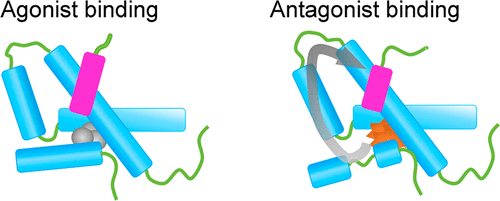当前位置:
X-MOL 学术
›
J. Chem. Inf. Model.
›
论文详情
Our official English website, www.x-mol.net, welcomes your feedback! (Note: you will need to create a separate account there.)
Molecular Dynamics Simulations Revealed the Regulation of Ligands to the Interactions between Androgen Receptor and Its Coactivator
Journal of Chemical Information and Modeling ( IF 5.6 ) Pub Date : 2018-07-11 00:00:00 , DOI: 10.1021/acs.jcim.8b00283 Na Liu 1, 2 , Wenfang Zhou 3 , Yue Guo 1, 2 , Junmei Wang 4 , Weitao Fu 3 , Huiyong Sun 3 , Dan Li 3 , Mojie Duan 1 , Tingjun Hou 3
Journal of Chemical Information and Modeling ( IF 5.6 ) Pub Date : 2018-07-11 00:00:00 , DOI: 10.1021/acs.jcim.8b00283 Na Liu 1, 2 , Wenfang Zhou 3 , Yue Guo 1, 2 , Junmei Wang 4 , Weitao Fu 3 , Huiyong Sun 3 , Dan Li 3 , Mojie Duan 1 , Tingjun Hou 3
Affiliation

|
The androgen receptor (AR) plays important roles in gene expression regulation, sexual phenotype maintenance, and prostate cancer (PCa) development. The communications between the AR ligand-binding domain (LBD) and its coactivator are critical to the activation of AR. It is still unclear how the ligand binding would affect the AR–coactivator interactions. In this work, the effects of the ligand binding on the AR–coactivator communications were explored by molecular dynamics (MD) simulations. The results showed that the ligand binding regulates the residue interactions in the function site AF-2. The ligand-to-coactivator allosteric pathway, which involves the coactivator, helix 3 (H3), helix 4 (H4), the loop between H3 and H4 (L3), and helix 12 (H12), and ligands, was characterized. In addition, the interactions of residues on the function site BF-3, especially on the boundary of AF-2 and BF-3, are also affected by the ligands. The MM/GBSA free energy calculations demonstrated that the binding affinity between the coactivator and apo-AR is roughly weaker than those between the coactivator and antagonistic ARs but stronger than those between the coactivator and agonistic ARs. The results indicated that the long-range electrostatic interactions and the conformational entropies are the main factors affecting the binding free energies. In addition, the F876L mutation on AR-LBD affects the ligand-to-coactivator allosteric pathway, which could be the reason for point mutation induced tolerance for the antagonistic drugs such as enzalutamide. Our study would help to develop novel drug candidates against PCa.
中文翻译:

分子动力学模拟揭示了配体对雄激素受体与其共活化剂之间相互作用的调控。
雄激素受体(AR)在基因表达调节,性表型维持和前列腺癌(PCa)发育中起重要作用。AR配体结合域(LBD)及其共激活剂之间的通讯对于AR的激活至关重要。尚不清楚配体结合将如何影响AR-共激活剂的相互作用。在这项工作中,通过分子动力学(MD)模拟探索了配体结合对AR-共活化剂通讯的影响。结果表明,配体结合调节功能位点AF-2中的残基相互作用。表征了涉及共活化剂,螺旋3(H3),螺旋4(H4),H3和H4之间的环(L3)和螺旋12(H12)的配体-共活化变构途径,以及配体。此外,BF-3功能位点,尤其是AF-2和BF-3边界上的残基之间的相互作用也受到配体的影响。MM / GBSA自由能计算表明,共活化剂和apo-AR之间的结合亲和力比共活化剂和拮抗AR之间的结合亲和力弱,但比共活化剂和激动性AR之间的结合亲和力强。结果表明,长距离静电相互作用和构象熵是影响结合自由能的主要因素。此外,AR-LBD上的F876L突变影响配体-共激活因子的变构途径,这可能是点突变诱导对恩杂鲁胺等拮抗药耐受的原因。我们的研究将有助于开发针对PCa的新型候选药物。尤其是在AF-2和BF-3的边界上,也受到配体的影响。MM / GBSA自由能计算表明,共活化剂和apo-AR之间的结合亲和力比共活化剂和拮抗AR之间的结合亲和力弱,但比共活化剂和激动性AR之间的结合亲和力强。结果表明,长距离静电相互作用和构象熵是影响结合自由能的主要因素。此外,AR-LBD上的F876L突变影响配体-共激活因子的变构途径,这可能是点突变诱导对恩杂鲁胺等拮抗药耐受的原因。我们的研究将有助于开发针对PCa的新型候选药物。尤其是在AF-2和BF-3的边界上,也受到配体的影响。MM / GBSA自由能计算表明,共活化剂和apo-AR之间的结合亲和力比共活化剂和拮抗AR之间的结合亲和力弱,但比共活化剂和激动性AR之间的结合亲和力强。结果表明,长距离静电相互作用和构象熵是影响结合自由能的主要因素。此外,AR-LBD上的F876L突变影响配体-共激活因子的变构途径,这可能是点突变诱导对恩杂鲁胺等拮抗药耐受的原因。我们的研究将有助于开发针对PCa的新型候选药物。MM / GBSA自由能计算表明,共活化剂和apo-AR之间的结合亲和力比共活化剂和拮抗性AR之间的结合亲和力弱,但比共活化剂和激动性AR之间的结合亲和力强。结果表明,长距离静电相互作用和构象熵是影响结合自由能的主要因素。此外,AR-LBD上的F876L突变影响配体-共激活因子的变构途径,这可能是点突变诱导对恩杂鲁胺等拮抗药耐受的原因。我们的研究将有助于开发针对PCa的新型候选药物。MM / GBSA自由能计算表明,共活化剂和apo-AR之间的结合亲和力比共活化剂和拮抗AR之间的结合亲和力弱,但比共活化剂和激动性AR之间的结合亲和力强。结果表明,长距离静电相互作用和构象熵是影响结合自由能的主要因素。此外,AR-LBD上的F876L突变影响配体-共激活因子的变构途径,这可能是点突变诱导对恩杂鲁胺等拮抗药耐受的原因。我们的研究将有助于开发针对PCa的新型候选药物。
更新日期:2018-07-11
中文翻译:

分子动力学模拟揭示了配体对雄激素受体与其共活化剂之间相互作用的调控。
雄激素受体(AR)在基因表达调节,性表型维持和前列腺癌(PCa)发育中起重要作用。AR配体结合域(LBD)及其共激活剂之间的通讯对于AR的激活至关重要。尚不清楚配体结合将如何影响AR-共激活剂的相互作用。在这项工作中,通过分子动力学(MD)模拟探索了配体结合对AR-共活化剂通讯的影响。结果表明,配体结合调节功能位点AF-2中的残基相互作用。表征了涉及共活化剂,螺旋3(H3),螺旋4(H4),H3和H4之间的环(L3)和螺旋12(H12)的配体-共活化变构途径,以及配体。此外,BF-3功能位点,尤其是AF-2和BF-3边界上的残基之间的相互作用也受到配体的影响。MM / GBSA自由能计算表明,共活化剂和apo-AR之间的结合亲和力比共活化剂和拮抗AR之间的结合亲和力弱,但比共活化剂和激动性AR之间的结合亲和力强。结果表明,长距离静电相互作用和构象熵是影响结合自由能的主要因素。此外,AR-LBD上的F876L突变影响配体-共激活因子的变构途径,这可能是点突变诱导对恩杂鲁胺等拮抗药耐受的原因。我们的研究将有助于开发针对PCa的新型候选药物。尤其是在AF-2和BF-3的边界上,也受到配体的影响。MM / GBSA自由能计算表明,共活化剂和apo-AR之间的结合亲和力比共活化剂和拮抗AR之间的结合亲和力弱,但比共活化剂和激动性AR之间的结合亲和力强。结果表明,长距离静电相互作用和构象熵是影响结合自由能的主要因素。此外,AR-LBD上的F876L突变影响配体-共激活因子的变构途径,这可能是点突变诱导对恩杂鲁胺等拮抗药耐受的原因。我们的研究将有助于开发针对PCa的新型候选药物。尤其是在AF-2和BF-3的边界上,也受到配体的影响。MM / GBSA自由能计算表明,共活化剂和apo-AR之间的结合亲和力比共活化剂和拮抗AR之间的结合亲和力弱,但比共活化剂和激动性AR之间的结合亲和力强。结果表明,长距离静电相互作用和构象熵是影响结合自由能的主要因素。此外,AR-LBD上的F876L突变影响配体-共激活因子的变构途径,这可能是点突变诱导对恩杂鲁胺等拮抗药耐受的原因。我们的研究将有助于开发针对PCa的新型候选药物。MM / GBSA自由能计算表明,共活化剂和apo-AR之间的结合亲和力比共活化剂和拮抗性AR之间的结合亲和力弱,但比共活化剂和激动性AR之间的结合亲和力强。结果表明,长距离静电相互作用和构象熵是影响结合自由能的主要因素。此外,AR-LBD上的F876L突变影响配体-共激活因子的变构途径,这可能是点突变诱导对恩杂鲁胺等拮抗药耐受的原因。我们的研究将有助于开发针对PCa的新型候选药物。MM / GBSA自由能计算表明,共活化剂和apo-AR之间的结合亲和力比共活化剂和拮抗AR之间的结合亲和力弱,但比共活化剂和激动性AR之间的结合亲和力强。结果表明,长距离静电相互作用和构象熵是影响结合自由能的主要因素。此外,AR-LBD上的F876L突变影响配体-共激活因子的变构途径,这可能是点突变诱导对恩杂鲁胺等拮抗药耐受的原因。我们的研究将有助于开发针对PCa的新型候选药物。



























 京公网安备 11010802027423号
京公网安备 11010802027423号